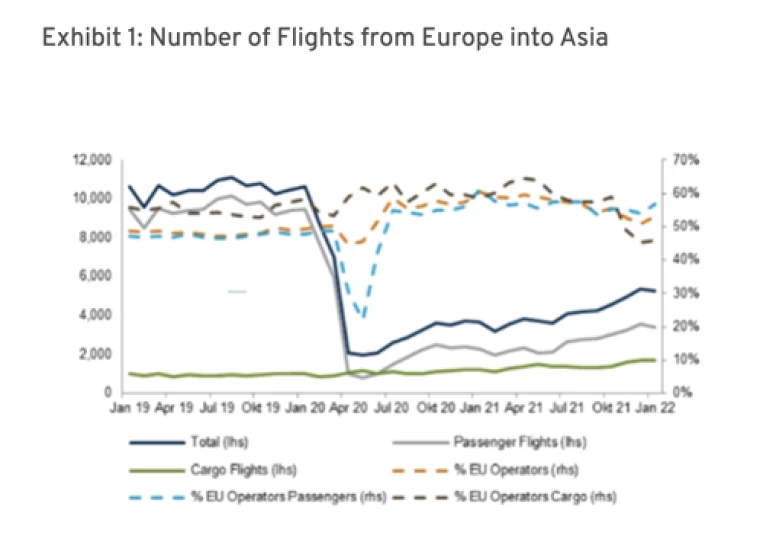The ongoing conflict between Russia and Ukraine is expected to drive up air cargo costs in the medium-term with the Asia-Europe lane seen to feel the most squeeze in both rates and capacity according to a new analysis from the Baltic Exchange Air Freight Index (BAI Index).
Writing in the BAI Index round-up, Bruce Chan, director & senior analyst, global logistics & future mobility equity research, at investment bank Stifel noted that two years into the pandemic, the industry is still reeling from the "capacity and pricing ramifications" of the Covid-19 pandemic.
He said current geopolitical risks will further drag the expected recovery of the industry and supply shocks "will be felt more acutely, as there is less of a capacity buffer to absorb them."
Squeeze on Asia-Europe lane
In the analysis, Chan said near term, direct price increases will result from higher fuel costs, and the potential for surcharges if carriers feel the need to offset longer routes and lower payloads. Indirectly, supply has come out of the system, which will put pressure on market pricing — particularly on the Asia -Europe lane.
"Near term, we think the impact of war in Ukraine is reductive to supply and inflationary to pricing. On the supply side, the immediate closure of air space above Ukraine, Russia, and other countries means disruption to certain existing flight paths, adding time, distance, or additional stops," he added.
"About 50% of Asia-Europe flights are operated by European airlines, making them directly subject to a diversion around Russian air space, increasing route length and effectively decreasing supply as more fuel is used and payloads have to be limited to accommodate longer, diverted transits."
The ban of Russian airlines in the EU airspace is also expected to further add pressure to the air cargo market with Aeroflot and AirBridgeCargo impacted by such restrictions — with the latter being a top-20 global provider.
With 18 widebody freighters, Chan said the restrictions impacting AirBridgeCargo will be further reducing an "already tight capacity on Asia-Europe lanes."

"Less tangibly, there is potential for significant operational disruption as a result of collateral cyber warfare," the Stifel executive added, citing the case of Expeditors International falling victim to such attacks which have caused significant disruptions to their service.
"While that particular disruption may not get reflected in underlying air cargo capacity pricing, it will be felt by those who consume air cargo and air freight forwarding services," he added, although Chan said there hasn't been "clear evidence" how such events impact pricing.
"We do expect to see more substantial increases in subsequent weeks as the market has time to absorb recent events, and we expect most of the effect on Europe-based lanes," he added.
Citing BAI data, the report noted that so far, on Asia-to-North America lanes, rates cooled sequentially this week out of Hong Kong (BAI32) by almost 18% and 16% out of Shanghai Pudong (BAI82) — although still 43% and 28% higher respectively compared to 2021.
On the Asia-to-Europe side, rates this week fell 16% sequentially out of Hong Kong (BAI31) and rose 6% out of Shanghai (BAI81) although both are also up around 26% and 32% each versus the same period in 2021.
Further supply chain disruptions
"As far as the global supply chain, we see many of the same broad, fundamental supply issues in 2022 as we experienced during 2021, meaning no quick fix to the present quagmire," Chan said. "Recent geopolitical events should only serve to further disrupt an already constricted global air cargo capacity."
Chan said the "elephant in the room" that could see a "quick fix" to the current disruption is a significant deterioration in demand.
"While we do not anticipate a significant shock in the near term, the added pressure of higher energy prices on already-historic inflation may make such deterioration more likely," he added.
"In short, we think recent events make it likely that prices go higher in the near term. And, while it is not our base case, we think recent events also make it more likely that there could be material, longer-term, demand destruction, which would push prices sharply lower."



